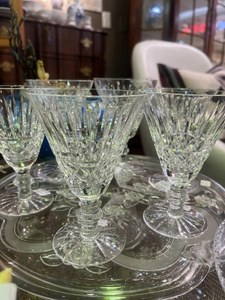Waterford Glassworks was created by George and his nephew, William Penrose in 1783 on land adjacent to Merchants' Quay in the heart of the Irish harbor town of Waterford, just minutes from the present-day House of Waterford Crystal. Their vision was to create the finest quality crystal for drinking vessels and objects of beauty for the home. They enjoyed great success until 1853 when they were forced to close down due to the downturn in the business climate of the day.
There were many attempts to revive the once thriving business, but it wasn’t until 1947 that it succeeded. An Irish jeweller, Bernard Fitzpatrick, convinced the Czech glassmaker, Karl Bacik, to relocate to Ireland to restart in Waterford after World War II. Having his country taken over by the USSR and his factories nationalised, Bacik accepted the offer and appointed fellow Czech, Miroslav Havel as chief designer. Havel spent many hours in the National Museum of Ireland studying the surviving crystal produced by the Penroses during the preceding centuries. In 1952 Havel created the Waterford pattern, Lismore, that would became the world’s best selling crystal.
Through the years, Waterford Crystal produced exquisite stemware, chandeliers, trophies and objets d’art. It also made the elaborate chandeliers for Westminster Abbey and the New Year’s Eve Ball dropped each year in Times Square.
In 2009 the Waterford Crystal plant in Killarney was shut down due to the company being placed in receivership. The company was transferred to WWRD Holdings Ltd during this time. Fiskars Corporation (a Finnish maker of home products) bought the company outright in 2015.
Today Waterford crystal is mostly produced outside Ireland in countries like Slovenia, Czech Republic, Hungary and Germany. The “Waterford” acid makers mark will most likely appear on the stem’s base, but can also be found in the grooves as well. Pieces made prior to 2000 will have the company name in a Gothic-script, while newer pieces include the company’s seahorse trademark.
At Ghorbany Benmore we have a great collection of the Waterford Tramore stemware in stock.



